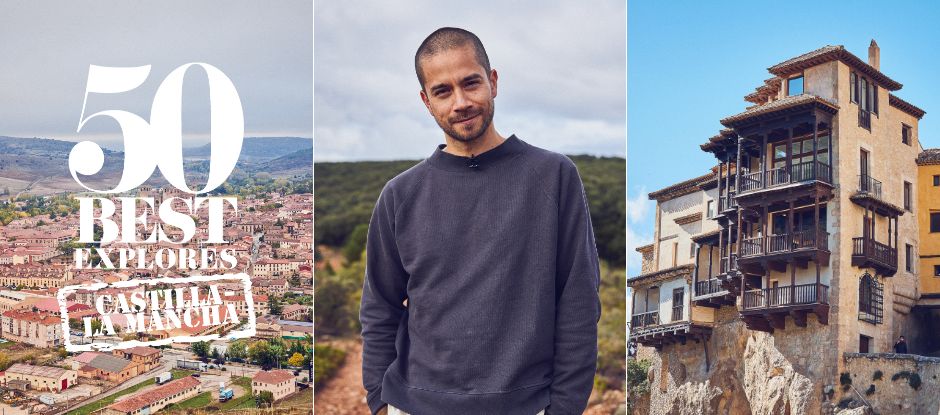Join chef Jeremy Chan on a trip around Castilla-La Mancha as he meets the community, discovers local flavours, samples traditional recipes and investigates ancient techniques kept alive by local cooks and producers to safeguard the Spanish region’s ancient culinary heritage
Castilla-La Mancha is an area rich in natural resources, high quality ingredients and unique flavours. From the giant windmills that inspired Miguel de Cervantes in Don Quixote to the history preserved in the walls of its medieval towns, as well as the delicious cheese, unique honey and flavourful truffles produced here, the region has a lot to offer to the most discerning traveller.
But as Jeremy Chan – chef-director of Ikoyi in London, winner of the American Express One To Watch Award 2021 and No.35 in The World’s 50 Best Restaurants 2023 – steps off the plane for the third and final trip as part of the 50 Best Explores Castilla-La Mancha travel series, the region is a question mark for him. His memories of Spain are linked to the time he spent in the country 10 years ago, when he lived in Madrid working in finance – but Spanish gastronomic culture and the enjoyment the capital’s inhabitants derived from local food and drinks inspired him to become a chef.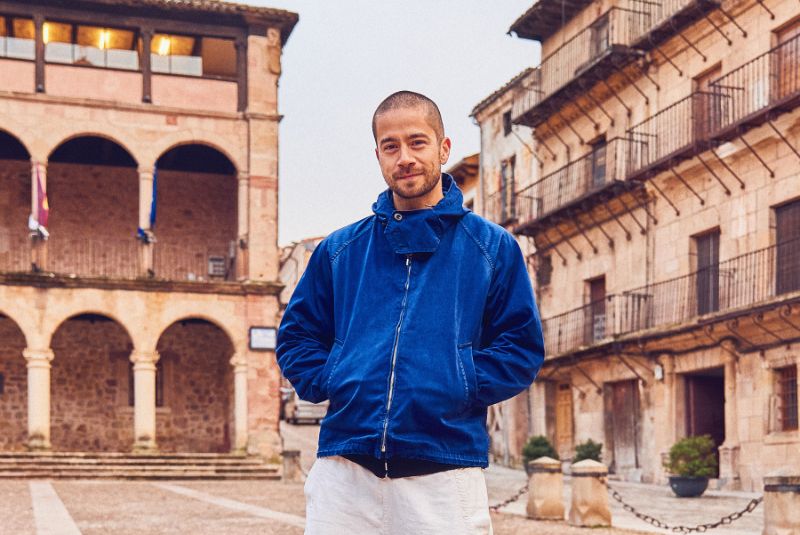
Jeremy Chan explored the Cuenca and Guadalajara provinces for the first time with 50 Best Explores
Despite being just two hours’ drive east of Madrid, the town of Cuenca – set in the mountains of east-central Spain – offers a very different vibe than the cosmopolitan capital where Chan lived. A magnificent settlement where urbanisation meets nature and the two become one, Cuenca features hilly roads and houses hanging on the side of the mountains, overlooking a lush valley where agriculture has long been the predominant occupation.
In the middle of this incredible landscape sits Jesús Segura’s restaurant, Casas Colgadas (hanging houses), located in the most famous building in the city, hugging the mountain with superb views of the valley below. Here, Segura serves a delicious menu based on research and interpretation of the local environment, keeping his ancestors’ knowledge alive and sourcing from local producers. “For us, the real value is no longer the product itself, but the wisdom behind the product or medicinal plant," he highlights.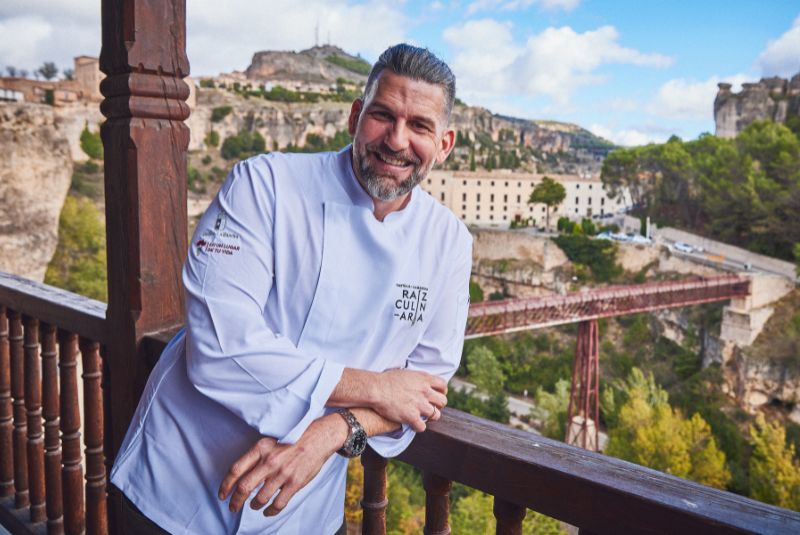
Chef Jesús Segura created his ‘Tasting Cuenca’ menu in 2022 to celebrate local ingredients
Take, for instance, El Sarajo, a dish that he makes with casquerías (offal) and whose recipe has been passed down for four generations, having been served in the city for more than 400 years. A floral dessert also features a local acorn, similar to elderberry, called sauco, which has more vitamins than an orange – all served in a beautiful dining room overlooking the stunning scenery, prompting Chan to highlight to Segura: “To be able to come here every day and look out into this valley, it must be quite special.”
Elsewhere in Cuenca, in the nearby village of Huerta del Marquesado, Olga García and Alejandro Paz are offering a new perspective on sustainability at their restaurant Fuentelgato. The charming young couple offers a modern yet homey menu that has become the talk of the town among food cognoscenti. “The menu changes according to the seasons, with fish and vegetables reigning supreme during spring and summer, while in autumn and winter, we use game meat with a focus on stews,” says García.

Fuentelgato’s menu changes regularly according to produce availability
Opened in 2015 as a bar, in 2020 García and Paz converted the space into its current format: a cosy and welcoming 16-seat restaurant run solely by the couple. In recent years, they have turned the biggest challenge posed by climate change into a major advantage. "The seasons are very blurred and often mixed, making it difficult to predict the longevity of a product," says García. This situation forces them to be more creative and adaptable, enabling them to extract maximum value from their ingredients, even if it means offering some dishes for only two weeks. “I really like their style of cooking, which is simple and very modern. It iterates the sense of place, of home and of the region,” highlights Chan.
Ancient methods for great produce
The economy of Castilla-La Mancha is strongly based on agriculture and husbandry, representing 11 per cent of the regional GDP. Wheat, grapes, olives, garlic, black truffles, saffron and pistachio nuts are all grown in the area, alongside some of the largest vineyards in Europe.
More than a third of the agricultural activity is linked to wheat and the jewel in the crown is Despelta, a company that makes organic flours from ancient wheat using a traditional stone mill, cultivating the cereal ecologically at 1,000 metres above sea level. Seeing the company’s commitment to avoid wasting even a milligram of wheat, Chan highlights: “Every single part of the wheat has a purpose, everything is processed and cleaned. This complete organic system is really satisfying and inspiring to see.”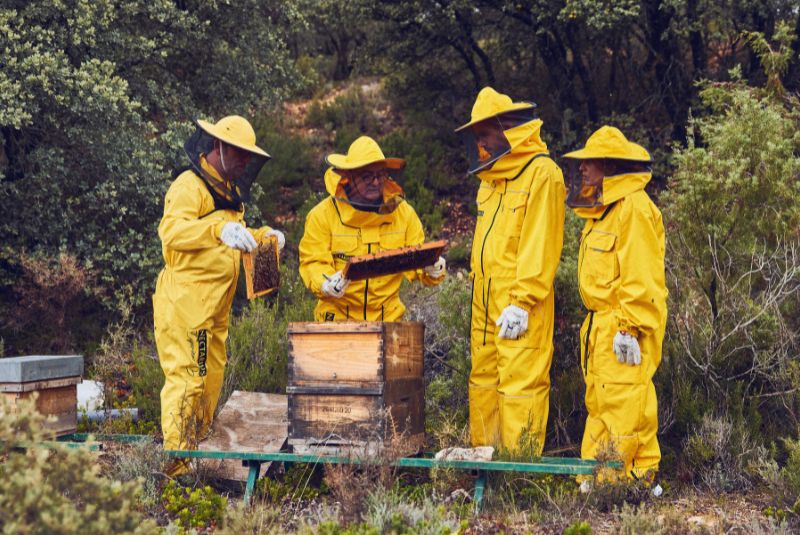
Different types of honey are extracted from the same beehives at local producer Nectarius
Apiculture is another significant part of the region’s economy. The honey produced here, miel de la Alcarria, has a protected designation of origin and its deliciousness is closely linked to its producers paying the maximum respect to the environment and the bees. Javier Marigil, founder of small-batch producer Nectarius, explains: “The special characteristics of the climate, soil and vegetation mean that by placing the bees in the right places at the right times, we can extract the same types of honey that our ancestors consumed. Beehives in the same place produce different kinds of honey with different flavours, colours and smells.”
Both Despelta and Nectarius keep the knowledge of their ancestors alive while passing it on to the new generations, always with the purpose of creating delicious quality products – but above all, respecting the natural resources that have sustained the region for decades.
The flavours of Guadalajara
Guadalajara is a mountainous municipality that has been inhabited since the Palaeolithic Age and its breath-taking scenery explains why people have chosen this area as their home in the centuries since. Beautiful lakes and hills, a national park and a medieval town dotted with stone houses and Gothic churches make the area a must-visit – the succulent local food and incredible hospitality provide the cherry on the cake.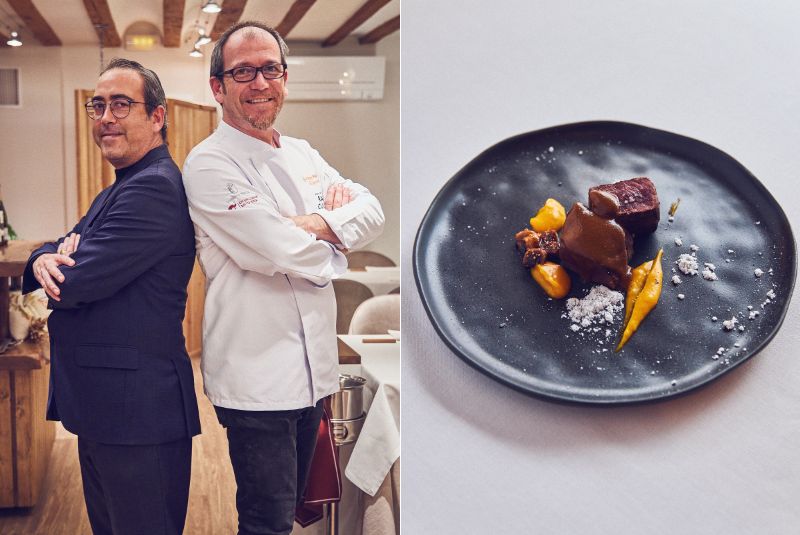
Enrique and Eduardo Pérez come from a four-generation hospitality family
At restaurant El Doncel, chef Enrique Pérez and his brother Eduardo combine their passion for autochthonous ingredients with creative techniques, resulting in colourful and playful dishes that taste even better than they look. Their dedication to the land and interest in giving back to the community are present in every dish – such as trout tartare, autumn mushrooms, charcoal venison and crème brûlée with pollen and honey – which are all created primarily with endemic products and presented on plates crafted by a local artisan. "We make a product-focused, local and honest cuisine," explains Pérez simply.
Another pair of siblings who share the same passion for the community are chef Samuel Moreno and sommelier Blanca, owners of Molino de Alcuneza, a restaurant located inside a still operative ancient mill. The eatery, hidden in a magical and rural corner of the municipality of Alcuneza, was bought by Morenos’ parents in the 1990s as a personal residence, then converted into a modest hotel with a restaurant for guests. In 2004, the siblings took the reins and started to grow the project into its current format: a 17-room hotel with two restaurants and a spa.
At Molino de Alcuneza, Chan sampled some of the restaurant’s creations, including mature cheese with olive oil and black truffle, a croquette of Iberian ham with organic local rye flour and piglet with garlic sauce. However, one dish stood out by taking him back to his formative years in Hong Kong: a Manchegan black garlic soup with mushrooms. “It’s similar to a bowl of ramen – a broth of black garlic and reduced chicken stock, with slices of mushroom cooked very al dente with egg. It’s a very inspirational, modern dish, but it also has the flavours of the locality,” highlights the chef. 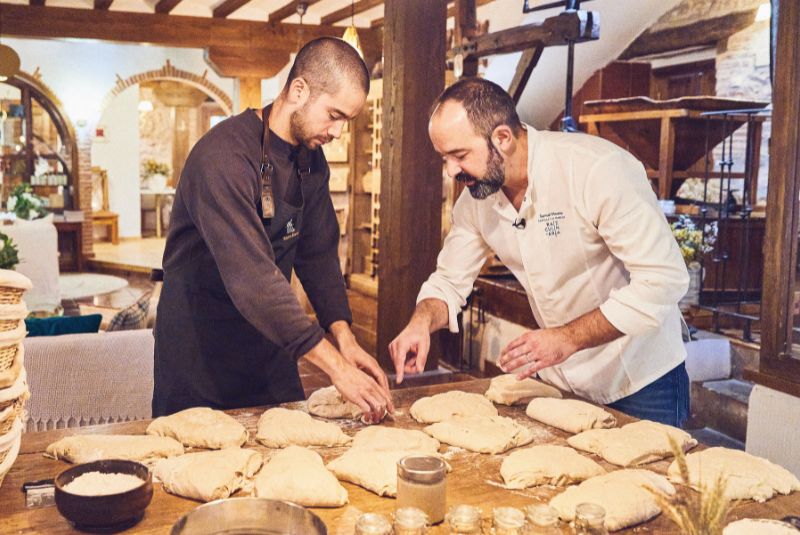
Chan and Moreno bake sourdough bread using Despelta flour at Molino de Alcuneza
The Morenos are not only interested in cooking delicious food and delivering excellent hospitality, but they also serve the community and the environment with initiatives such as Guardianes del Territorio (guardians of the territory). This campaign creates awareness about the great work done by local producers. “It’s in our DNA to make tourism more sustainable and regenerative, trying to leave our area and our environment better than we found it,” says Moreno. Chan highlights: “Seeing this 500-year-old mill moving around in the restaurant really gave me a sense of time, a sense of place and history of the building.”
After a five-day adventure across Castilla-La Mancha and before returning to London and to his restaurant Ikoyi – where he combines spices from Africa and Asia with British ingredients and international techniques – Chan highlights his connection with the region’s people, always willing to share their knowledge and passion with a big smile and an open heart. “I don't think I've experienced this level of generosity and warmth in a very long time,” he says. “That's something very special that I'm going to remember about this region: the consistency of warmth of everyone that I've met.”
Join Jeremy Chan on his trip around Castilla-La Mancha in the video:
Now read how chef Eric Ripert fell in love with Manchego cheese and what Manu Buffara discovered on her exploration of Castilla-La Mancha, then browse restaurant and bar recommendations in Spain and across the world on the 50 Best Discovery website. Follow 50 Best on Instagram, Facebook, X and YouTube for the latest news, features and videos.
